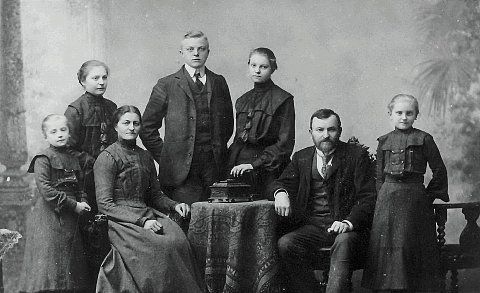-
HomeDNA
review on October 1, 2018
by Ellen Hinkley

At a Glance
Summary
Overall, GPS Origins offers something a bit different to other genetic ancestry services. The ‘Gene Pool Percentages’ are fascinating, and the ‘DNA Migration Maps’ are really engaging.
For those like myself whom upload their raw data to GPS Origins instead of buying the full test, I was expecting to see only a weak correlation between the GPS Origins results and the results from other services (uploading raw data to GPS Origins means that fewer genetic variants can be accessed to provide the results). However, in my case, GPS Origins corresponds very well with my AncestryDNA results and with my parents’ and grandparents’ AncestryDNA results.
The price is higher than for uploading your raw data to Family Tree DNA or DNA Tribes, but I think it’s definitely worth the money if you’re looking for emerging patterns in your ethnic breakdown and you choose to upload raw data instead of buying the full test. I also think that the GPS Origins migration maps can help you figure out some of the anomalies that you may have come across when using other tools (e.g. GEDMatch) as they have done for me!
Full Review
GPS Origins is produced by DNA Diagnostics Center; they believe that advancement in technology should translate to services that are available for everyone. They are globally recognized and offer an array of DNA testing services.
The full GPS Origins test analyzes over 730,000 genetic variants which is more than 23andMe, Family Tree DNA, AncestryDNA or National Geographic. It uses in-depth analysis to work out your ancestors’ migration route, as well as your top three ancestral origins.
Although I was uploading my raw data to GPS Origins to take the test, I was intrigued to see how the results would compare to my AncestryDNA and Family Tree DNA results. I hoped GPS Origins would help me figure out some of the discrepancies I’ve found when uploading my data to other sites for an ancestral analysis.
Product Expectations
GPS Origins was unknown to me until I stumbled across a thread on the Anthrogenica forum. As I had recently uploaded my raw data to DNA Tribes for some interesting results, I was eager to compare. As GPS Origins analyzes more genetic variants than other tests, I was hoping they’d be able to be more specific as to the origin of my ancestors.
Apart from the ethnic origin breakdown, the next thing I was most intrigued about was the migration map, as it doesn’t just give you one route, but two, so you should get a much clearer idea of where your ancestors are from and travelled to. Because of this, I was hoping that it would explain some of the more exotic populations that have been identified in my ethnic mix by other companies.
Online Registration
First you’ll have to set up a profile which is fairly straightforward. There’s also a questionnaire you can complete to give GPS Origins information about your mother and father’s lineage, which will help them refine their data and algorithms.
Ordering Experience
Once you’ve completed your profile you can either choose the full DNA kit (which they’ll post to you) or the raw data upload.
When you’ve chosen the raw data upload, GPS Origins will ask you to upload the data file and when complete, you’ll have to wait another 5-15 minutes for the data to be processed. This is the bit I struggled to get my head around as I expected to have to pay before uploading my raw data, but you actually pay after it’s been uploaded and processed.
Once I made the payment I got instant access to my ethnic breakdown and migration routes.
The Results
The results sections are self-explanatory, divided into two main sections: ‘Gene Pool Percentages’ and ‘DNA Migration Routes’, with some additional charts and maps for both.
There’s also a ‘Your Profile’ section which gives you the option to download your results, however, when I tried to do this, I was simply taken to the top of the page. I don’t know if they’d removed this function for customers who’d uploaded their data, or whether it’s a bug, but it’s frustrating if you want to download your results to go over them offline.
Results Section: Gene Pool Percentages
When you scroll down to the first results section you will see a map of your ‘Top 3 Gene Pools’. You can click on each gene pool to show it on the map (shown below). I liked that the color intensity indicated where the pool is most prevalent, this was a nice feature.
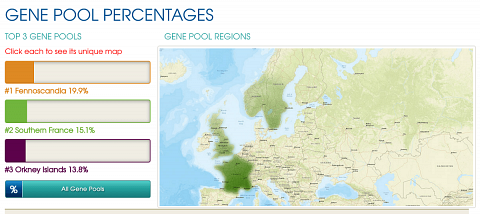
My Gene Pool Percentages.
Underneath the Top 3 Gene Pools and Gene Pool Regions you can read about the regions, from the history of agriculture and language in that area, to the migration patterns that occurred there – I thought this was awesome!
You can see your full gene pool results by clicking the ‘All Gene Pools’ button, shown below:
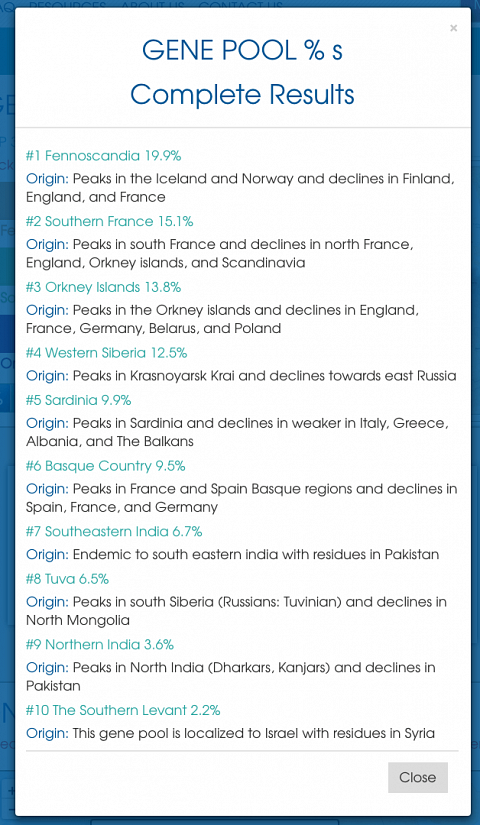
My full Gene Pool results.
As you can see it showed me the top 10 gene pools that have contributed to my DNA, starting with the highest percentage down to the lowest. One thing I noticed when comparing my GPS Origins results to those of other customers is that Fennoscandia and Orkney Islands are in the top three gene pools for anyone with Northwest European ancestry (individuals located in the UK and US mostly).
I definitely got a few surprises, the Tuva gene pool for example, which originates between the Russian and Mongolian border. I feel like this part of my ethnicity must be incredibly ancient rather than anything I can realistically trace in recent generations of my family. That said, I’ve read some intriguing articles about Siberian gene pools contributing to the DNA of modern Native Americans. Interestingly, DNA Tribes and the GEDMatch tool indicate that Native American populations have contributed to my ethnicity, so this corresponds with the Tuva result I’ve received!
One thing I would have liked from this section is perhaps a map that shows where the top 10 Gene Pool Percentages are from – it wasn’t obvious from the descriptions where these regions were located in the world.
Results Section: DNA Migration Routes
The second results section was focused on the migration routes that my ancestors would have taken hundreds, if not thousands of years ago. Two migration maps were shown, one for my maternal line and one for my paternal line (shown below). Unfortunately, I learned that GPS Origins was unable to distinguish which was which.
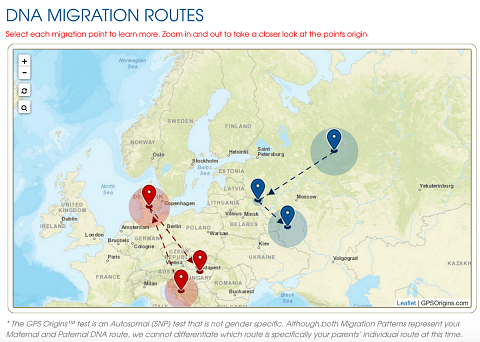
My DNA Migration Routes.
Each point of each migratory path showed the location of a population that had contributed to my ethnic mix. I was able to manipulate the map to focus on each point, and learn about the historical factors that caused the population groups to move. I thought this feature was fantastic, it was great to learn about these migration routes step by step.
I found that the DNA Migration Routes map corroborated the results I’ve received from other companies quite well. Beneath the map, GPS Origins went into more detail about the routes themselves, below is the description of my ‘Migration Route B’:
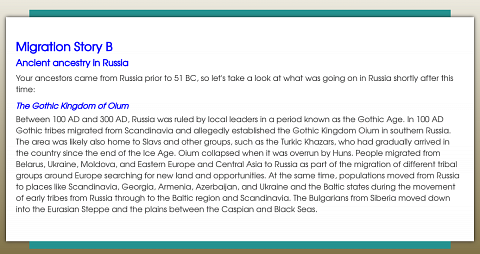
My Migration Story B.
The story really brought my ancestry alive. It was great to understand how my ancestors migrated through the region and to learn about what happened to cause the migration in the first place. It looks like the Huns had a good time in Russia, and this clearly links in with the Tuva result I’d received in the Gene Pool Percentages section.
I quite liked the narrative approach to this section, based on the fact that I like learning about obscure aspects of history. It also gave me a clearer idea of why I scored high for Scandinavian ethnicity, despite the fact that the migration routes of my ancestors seem to avoid Scandinavia all together!
Summary
Overall, GPS Origins offers something a bit different to other genetic ancestry services. The ‘Gene Pool Percentages’ are fascinating, and the ‘DNA Migration Maps’ are really engaging.
For those like myself whom upload their raw data to GPS Origins instead of buying the full test, I was expecting to see only a weak correlation between the GPS Origins results and the results from other services (uploading raw data to GPS Origins means that fewer genetic variants can be accessed to provide the results). However, in my case, GPS Origins corresponds very well with my AncestryDNA results and with my parents’ and grandparents’ AncestryDNA results.
The price is higher than for uploading your raw data to Family Tree DNA or DNA Tribes, but I think it’s definitely worth the money if you’re looking for emerging patterns in your ethnic breakdown and you choose to upload raw data instead of buying the full test. I also think that the GPS Origins migration maps can help you figure out some of the anomalies that you may have come across when using other tools (e.g. GEDMatch) as they have done for me!
Please note that we were invited to take this test free of charge.
Visit HomeDNA to learn more about this DNA testing service >

